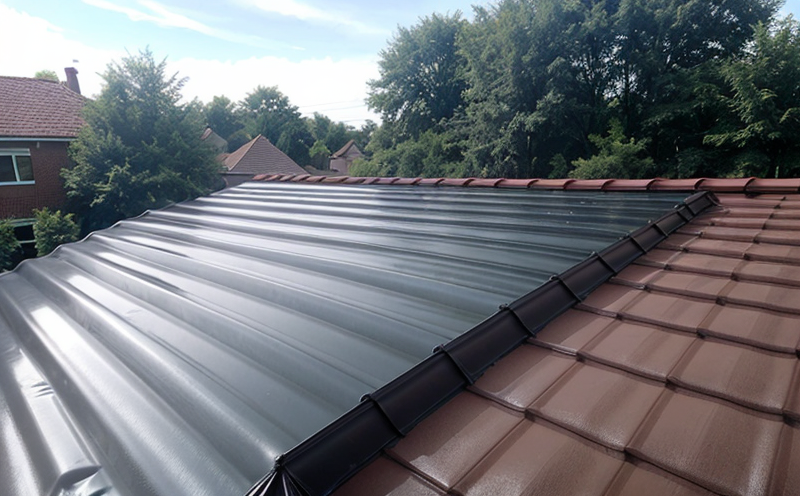ISO 4892 UV Resistance Testing of Roofing Materials
The ISO 4892-1 standard for the determination of resistance to heat aging and ultraviolet radiation is a critical test method used in the building & infrastructure sector. This international standard evaluates the long-term performance of materials under exposure to artificial weathering, simulating UV light from sunlight.
In roofing applications, materials are exposed to harsh environmental conditions that can lead to degradation over time. By subjecting roofing materials to controlled ultraviolet irradiance and high temperatures, this test assesses their ability to withstand such conditions without significant loss of performance or appearance. This is particularly important for ensuring the durability and longevity of roofs in various climates.
The testing process involves exposing a specimen cut from the material to UV radiation and heat in a special chamber designed to mimic real-world exposure. The specimen's color change, weight loss, and any changes in mechanical properties are monitored over time. Compliance with this standard is crucial for manufacturers aiming to meet market demands and regulatory requirements.
Our laboratory adheres strictly to ISO 4892-1 guidelines, ensuring accurate and reliable test results that can be trusted by industry professionals. We provide detailed reports highlighting the performance of roofing materials under UV exposure, helping clients make informed decisions about material selection and product quality assurance.
| Specimen Preparation | Test Conditions | Measurement Parameters |
|---|---|---|
| Cut specimens from the material to be tested. | Radiation exposure: 400-380 nm; Temperature: 75°C ±2°C. | Weight change, color change, tensile strength, elongation at break. |
This testing method is essential for ensuring the quality and durability of roofing materials. It helps manufacturers to identify potential issues early in the development process and allows them to optimize their products for better performance under real-world conditions. Our expertise in this area ensures that we can provide accurate, consistent results that are crucial for compliance with international standards.
Why It Matters
The durability and longevity of roofing materials are paramount to the overall performance of buildings. UV resistance testing is a cornerstone in ensuring that roofing products can withstand the harsh environmental conditions they encounter over their service life. This test ensures that roofs remain effective barriers against water penetration, heat transfer, and other environmental factors.
- Prevents premature failure due to sun exposure.
- Ensures compliance with industry regulations and standards.
- Supports the development of longer-lasting roofing materials.
By conducting UV resistance testing according to ISO 4892-1, manufacturers can improve product quality and extend the service life of their roofing materials. This not only enhances customer satisfaction but also contributes to sustainable building practices by reducing waste and replacing of materials over time.
Industry Applications
ISO 4892 UV resistance testing is widely used in the construction industry, particularly for roofing and waterproofing applications. This test ensures that materials meet stringent durability requirements, which are critical for maintaining the integrity of buildings over time.
- Rooftop insulation: Ensures that insulating materials remain effective against UV damage, maintaining energy efficiency.
- Membrane waterproofing: Verifies that membranes can withstand prolonged exposure to sunlight without degradation, which is essential for preventing leaks and water infiltration.
- Slate and tile roofing: Evaluates the resistance of natural materials like slate or tiles against UV-induced deterioration.
| Material Type | Main Application |
|---|---|
| Rubberized asphalt | Roofing membranes, waterproofing |
| Bonded bitumen | Straightforward roofing applications |
| Glass wool insulation | Innovative insulation solutions |
Testing according to ISO 4892-1 is essential for manufacturers and contractors alike, as it ensures that the materials they use meet the highest standards of durability and performance. This testing helps in selecting the most appropriate roofing materials for specific applications, thus ensuring long-term building performance.
Customer Impact and Satisfaction
The impact of ISO 4892 UV resistance testing on customer satisfaction cannot be overstated. By using this test method, manufacturers can provide products that are proven to last longer, perform better, and meet the highest standards of quality.
- Increased trust in product reliability: Customers have peace of mind knowing that their roofing materials are tested against rigorous international standards.
- Extended service life: Products that pass UV resistance testing are more likely to withstand harsh environmental conditions, reducing the need for premature replacements.
- Better reputation in the market: Compliance with ISO 4892-1 helps manufacturers establish a strong brand image and attract discerning customers.
Our laboratory offers comprehensive testing services that ensure customer satisfaction by providing accurate, reliable results. We work closely with our clients to understand their specific requirements and tailor our testing protocols accordingly. This commitment to quality has earned us a reputation for excellence in the industry.





